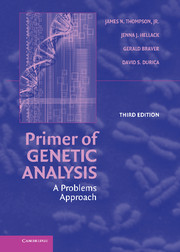Book contents
- Frontmatter
- Contents
- Preface
- Note on Genetic Symbols
- 1 Overview of Genetic Organization and Scale
- 2 Mitosis and Meiosis
- 3 Nucleic Acids: DNA and RNA
- 4 Basic Mendelian Genetics
- 5 Probability and Chi-Square
- 6 Sex-Linkage and Gene Interactions
- 7 Pedigree Analysis
- 8 Overview of Basic Statistical Testing
- 9 Quantitative Inheritance
- 10 Overview of Genetic Mapping
- 11 Assessing Chromosome Linkage Relationships
- 12 Linkage and Mapping in Diploids
- 13 Mapping in Bacteria and Viruses
- 14 Overview of Types of Genetic Change
- 15 Gene Mutation
- 16 Changes in Chromosome Number and Structure
- 17 Protein Synthesis and the Genetic Code
- 18 Gene Regulation and Development
- 19 Overview of Molecular Biology Techniques
- 20 DNA Mapping and Human Genome Analysis
- 21 Basic Population Genetics
- 22 Selection and Evolution
- 23 Practice Tests
- 24 Answers to Practice Tests and Crossword Puzzles
- 25 Landmarks in the History of Genetics
- Glossary
- Reference Tables
21 - Basic Population Genetics
Published online by Cambridge University Press: 05 June 2012
- Frontmatter
- Contents
- Preface
- Note on Genetic Symbols
- 1 Overview of Genetic Organization and Scale
- 2 Mitosis and Meiosis
- 3 Nucleic Acids: DNA and RNA
- 4 Basic Mendelian Genetics
- 5 Probability and Chi-Square
- 6 Sex-Linkage and Gene Interactions
- 7 Pedigree Analysis
- 8 Overview of Basic Statistical Testing
- 9 Quantitative Inheritance
- 10 Overview of Genetic Mapping
- 11 Assessing Chromosome Linkage Relationships
- 12 Linkage and Mapping in Diploids
- 13 Mapping in Bacteria and Viruses
- 14 Overview of Types of Genetic Change
- 15 Gene Mutation
- 16 Changes in Chromosome Number and Structure
- 17 Protein Synthesis and the Genetic Code
- 18 Gene Regulation and Development
- 19 Overview of Molecular Biology Techniques
- 20 DNA Mapping and Human Genome Analysis
- 21 Basic Population Genetics
- 22 Selection and Evolution
- 23 Practice Tests
- 24 Answers to Practice Tests and Crossword Puzzles
- 25 Landmarks in the History of Genetics
- Glossary
- Reference Tables
Summary
STUDY HINTS
The rules of Mendelian inheritance are largely based upon the probabilities of inheriting a given allele or combination of alleles from a specified genotype. With the exception of sex-linked traits, each individual carries at most two alleles of each gene, and the number of possible combinations is limited. Expectations can be calculated easily, since the probability of getting a certain allele from a known heterozygous diploid is p=q=.5.
In a population the focus changes from the genome to the gene pool and to estimates of allele frequency, yet the rules of probability still apply. Allele frequencies p and q are determined by pooling all of the genes carried by all of the individuals in the population. Working problems that require estimating allele and genotype frequencies from the Hardy–Weinberg relationship are fairly straightforward if you keep in mind that you are dealing with probabilities and if you are consistent with your use of symbols.
For example, if we let the frequency of the A allele be p and the frequency of the a allele be q in a population in Hardy–Weinberg equilibrium, p+q=1, as long as A and a are the only alleles at that locus segregating in the population. In other words, the probability of picking an A allele at random plus the probability of picking an a allele at random account for all possible events. The genotypes that can be produced and their probabilities are shown in the following table.
- Type
- Chapter
- Information
- Primer of Genetic AnalysisA Problems Approach, pp. 216 - 225Publisher: Cambridge University PressPrint publication year: 2007



